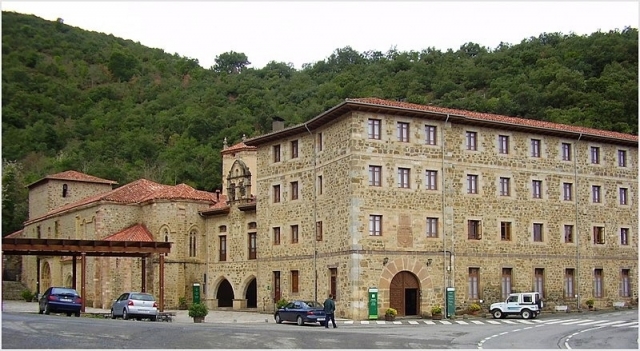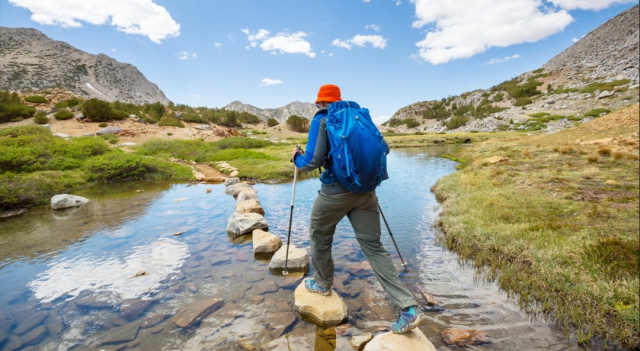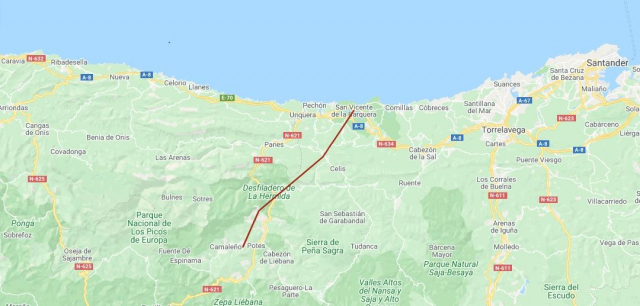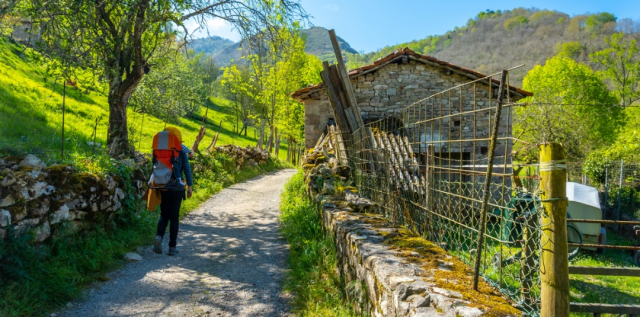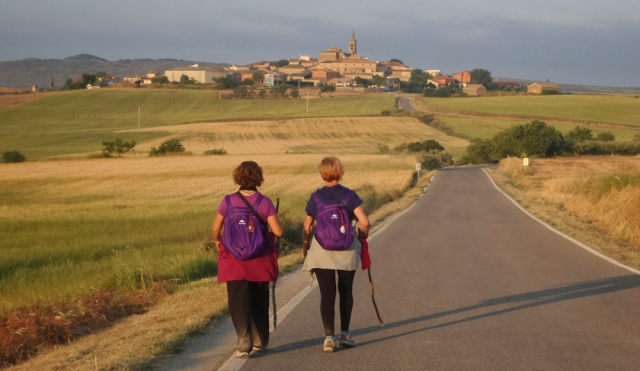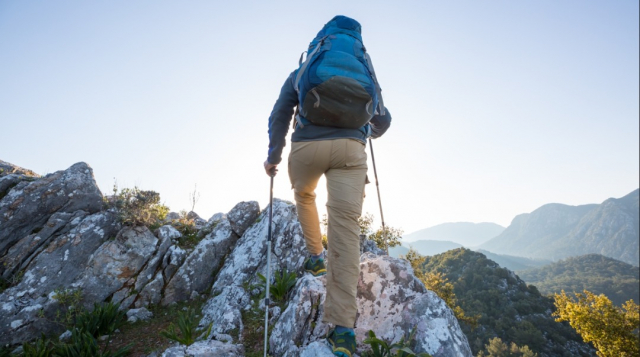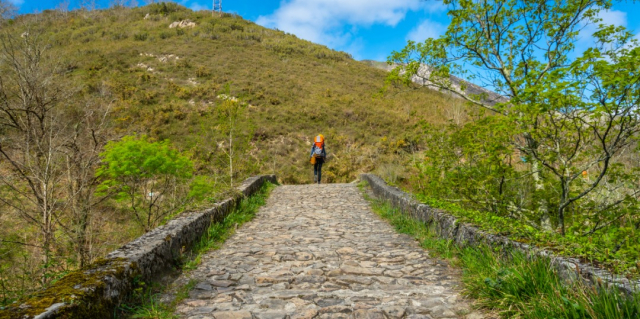The Lebaniego Way in 2024: Stages and Tips Guide
The pilgrimage to the Monastery of Santo Toribio is done to contemplate the largest piece of the Cross of Christ preserved.
- History of the Lebaniego Way
- Stages of the Lebaniego Way
- Stage 1: San Vicente de la Barquera - Cades
- Stage 2: Cades - Cabañes
- Stage 3: Cabañes - Santo Toribio
- Map of the Lebaniego Trail
- How many km are the Camino Lebaniego?
- What How difficult is the Camino Lebaniego?
- Where does the Camino Lebaniego end?
- When is the Lebaniego Door of Forgiveness closed?
- Tips for doing the Camino Lebaniego
- How to travel the Camino Lebaniego?
- How many days does it take to do the Camino Lebaniego?
- Where to eat and where to sleep?
- Where to stamp the Camino Lebaniego credential
- How to get the lebaniega?
- Differences between the Camino de Santiago and the Camino Lebaniego
- The Jacobean routes closest to the Camino Lebaniego
Although most of the routes in the Iberian Peninsula go in the direction of the Cathedral of Santiago, there are many other religious pilgrimage routes in Spain. One of them is located in the northern part of the peninsula, joining San Vicente de la Barquera with Santo Toribio. This route is known as El Camino Lebaniego.
History of the Lebaniego Way
Liébana has celebrated its jubilee period since the year 1512. A route with hundreds of years of history to Santo Toribio de Liébana, where pilgrims hoped to meet the largest relic of the Cross of Christ, the Lignum Crucis. Legend has it that the cross used by the Romans to crucify Christ was divided into several pieces, located in important points such as Jerusalem or Rome.
The pilgrimage to the Monastery of Santo Toribio begins after the bull of Pope Julius II, who in 1512 made the celebration of the Lebaniego Jubilee Year official. From that moment on, this enclave became an important pilgrimage center thanks to the conservation of the largest piece of the Cross of Christ. The pilgrims who walk to see this relic are known as cruisers, and the jubilee year is celebrated whenever April 16 (Santo Toribio) falls on a Sunday.
Stages of the Lebaniego Way
Despite being one of the most popular pilgrimage routes in Spain, the Camino Lebaniego is not exactly a very extensive route, especially if we compare it with some of the most important Jacobean routes. The Camino Lebaniego is divided into 3 stages as follows:
- Stage 1: San Vicente de la Barquera - Cades (28.5 kilometers)
- Stage 2: Cades - Cabañes (30.53 kilometers)
- Stage 3: Cabañes - Santo Toribio (13.7 kilometers)
Stage 1: San Vicente de la Barquera - Cades
The Lebaniego Way begins its journey in San Vicente de la Barquera, more specifically from the church of Our Lady of the Angels. We will continue the journey passing through Serdio about 8km away; continuing with Muñorrodero with a route of around 8km. The next point during this stage will be Cabanzón and finally arriving at Cades.
- Distance: Approximately 27 km
- Difficulty level: Moderate
- Points of interest: Coastal landscapes, Church of Santa María de los Ángeles
- Description: This initial section takes pilgrims through fascinating coastal landscapes, allowing them to immerse themselves in the natural and architectural beauty of the region. li>
Stage 2: Cades - Cabañes
Composed of just over 30km, the second stage of the Camino Labaniego is not complicated at all, although we must take certain aspects into account. Starting from Cades our objective will be We will reach the town of Cicera where we can find several points of interest. We are talking about the Picos de Europa or the Desfiladero de la Hermida, imposing enclaves of Cantabria on the Camino de Santiago.
- Distance: Approximately 15 km
- Difficulty level: Moderate
- Points of interest: Nansa River Valley, Traditional mountain architecture.
- Description: As they continue, pilgrims will be able to enjoy the picturesque Nansa river valley and experience the tranquility of the mountain.
Stage 3: Cabañes - Santo Toribio
The last of the stages of the Camino Lebaniego starts from Cabañes, traveling to Pendes and concluding in Tama. From Tama our next objective will be Potes, a town where we find a multitude of points of interest, especially highlighting once again the Picos de Europa. here We can also find other popular areas such as the Torre del Infantado or the Church of San Vicente.
- Distance: Approximately 13 km
- Difficulty level: High
- Points of interest: Mountainous landscapes, Santa María de Lebeña
- Description: This stage presents a greater challenge, taking pilgrims through mountainous terrain with breathtaking panoramic views and ending with the visit to the architectural jewel of Santa María de Lebeña.
The Lebaniego Way ends starting from Potes to the Monastery of Santo Toribio and the most enclave important of the entire journey. The building has two doors, the Puerta del Perdón being the most important of them. This opens every Santo Lebaniego year, or what is the same, every year that April 16 falls on a Sunday. This date is very important, since it is the anniversary of the monk Santo Toribio, in charge of bringing to Liébana the largest remains of the cross of Christ, the Lignum Crucis.
The route of the Camino Lebaniego is not one of the most complex and, when placed on the map, it shows us that it is an almost straight route. Next, we leave you with the points through which it goes like this. as its extension on the map. It is a route that is not excessively extensive and, luckily, it is not very difficult, so it is an ideal route for pilgrims who begin their journey in this way. as a relaxing route for those who have been doing this type of experience for some time. In total there are 72.73 kilometers that pilgrims must travel to complete the Camino Lebaniego and which are divided into 3 stages. The Camino Lebaniego is one of the simplest routes. In fact, it stands out for being an ideal option for those who want to start preparing for the Camino de Santiago or who are even looking for a more relaxed adventure. The only thing that pilgrims looking to begin this experience will need is, precisely, to have a certain habit of walking. After traveling the three stages of the Lebaniego Way, the pilgrims will reach the end of the route when they reach the Monastery of Santo Toribio as well as the Monastery of Santo Toribio. as the most important enclave of the entire route traveled. Upon reaching this place, pilgrims find a building that has two doors, the Door of Forgiveness being not only the most prominent, but also the most important. The Door of Forgiveness is famous and it is not surprising. Seeing it open is an honor for the pilgrims who can come to visit it. After all, it remains open only during the Lebaniego Jubilee Year, which is celebrated every year that April 16, the festival of Santo Toribio, falls on a Sunday. From this moment on, the door will open It will be open 365 days a year until April 15, at which time it will close. I opened the door and it won't come back. It will be open until the celebration of the next Lebaniego Jubilee Year. To successfully complete the Camino Lebaniego you must take into account the same advice that you will find for the Camino de Santiago; nothing complicated although as we already told you at the time it is never complicated. plus some preparation. And physical preparation is a very important aspect, regardless of the type of Camino chosen. Keep in mind that you are going to travel dozens and dozens of kilometers, so being well prepared is vitally important to endure the different routes and stages without fainting. Our best advice in this regard is to prepare yourself physically, getting your body used to long walks and increasing the distance as much as possible week by week. Hand in hand with the previous advice, it is inevitable to talk about footwear. Good boots or mountain shoes will be, without a doubt, our best ally during the Camino Lebaniego. Another important detail that you should keep in mind with footwear is to look for boots or sneakersthat are waterproof, capable of withstanding rain and low temperatures. Although there are very few who dare to do the Camino de Santiago without backpack, if it is your first time doing the Camino Lebaniego we recommend that the backpack does not exceed 10% of your weight. Keep in mind that it will be several days of walking so we are not interested in unnecessarily burdening our backs. In the same way as the Camino de Santiago, the Camino Lebaniego does not pose any type of obstacle to pilgrims who want to carry out the different stages either on foot, on horseback or by bike; even on horseback. However, as we have already mentioned before, it is important that you take into account everything related to signage. The red dates will indicate the route to follow for the Camino Lebaniego, while the yellow will do the same with the Camino del Norte towards Santiago de Compostela. The Camino Lebaniego has a great landscape and cultural wealth, but it does not have a single answer to the question of how many days are required to complete it. It largely depends on the individual physical condition and the pace that each pilgrim wishes to establish. In general, we can say that the complete journey covers approximately 72 kilometers, which most pilgrims manage to complete in an average of 4 to 5 days. This time allows for a moderate progression that makes it easy to enjoy the impressive nature and the historical monuments that adorn the path. In planning your trip we suggest that you consider the different stages of the journey, each with its own complexity and unique attractions. There are those who prefer to extend their experience to a week, allowing days of rest or dedicating time to explore the towns that are along the route, thus integrating the experience. a deeper and richer dimension to the pilgrimage. In addition, this extension in time provides the opportunity for gradual adaptation to the physical effort required, especially if you are not working. accustomed to long walks. Do not forget that the Camino Lebaniego, beyond Although it is a physical route, it is an opportunity to embark on an internal journey of reflection and renewal. Therefore, dear pilgrim, we invite you to, rather than focusing on the length of the journey, pay attention to what the journey can offer you in terms of experience and learning. May each step be an opportunity to discover, enjoy and grow, building an experience that, we are sure, will be enjoyable for you. unforgettable. You will have no problem finding hostels on the Camino del Norte or the Camino Lebaniego. During the stages, a multitude of hostels will cross your path where you can rest and spend the night. While it is true that you will not find any problems staying, it is never a problem. It is also necessary to be cautious and call in advance given the influx of pilgrims. The Pilgrim Credential is more than a simple document, it is a key that opens doors to an unforgettable experience on the Camino Lebaniego. This special passport is not onlywill serve Not only will it serve as a tangible record of your personal journey, marking each stage passed with unique stamps, but it will also facilitate your journey. access to hostels and other services dedicated to pilgrims. To always carry it with you is to carry a fragment of history and tradition that surrounds this ancient path, an invitation to be part of a community that, over the centuries, has also shared the same path of discovery and reflection. n staff. The Pilgrim's Credential can be acquired at specific points before starting the trip, such as in some churches, associations of friends of the Camino Lebaniego, or through the Pilgrim's Credential. s of theofficial website. It is recommended to always carry it with you, because at each stage you have the opportunity to stamp a distinctive seal, which not only verifies your passage on the pilgrimage, but also creates a personalized mosaic of the trip. p> Beyond Beyond its practical usefulness, the Pilgrim's Credential becomes a silent companion but significant during the journey. With it, each pilgrim writes a new page in the long history of the Camino Lebaniego, joining the narratives of countless travelers who preceded him. Although when doing the Camino de Santiago, pilgrims have their attention focused on obtaining the compostela, those who do the Camino Lebaniego cannot ignore the lebaniega. What is it the lebaniega? This is a document which is found in the monastery of Santo Toribio de Liébana. In this it is accredited that the pilgrims have made and completed the Lebaniego Way, reaching Santo Toribio de Liébana. Of course, this credential will be delivered, after verifying that all the seals have been obtained, in the monastery itself. As also the case with the Camino de Santiago, the Camino Lebaniego has its own credential. Pilgrims will obtain stamps in different hostels and establishments located along this path to finally obtain the Lebaniega, a document similar to the Compostela, for the Camino de Santiago. In the case of the Jubilee Year, you should know that the Camino Lebaniego has its own. The jubilee year for the Camino Lebaniego is any year where April 16 is a Sunday and covers the following 365 days, until April 15 of the following year. In 2023 the the75º Lebaniego Jubilee Year, since it was celebrated the first in 1512. Generally, pilgrims on the Camino de Santiago use the different routes of the Camino Lebaniego as a link due to its great connection with the Camino Francés and the Northern Path. On the other hand, and as we have already mentioned, the Camino Lebaniego has its own credential, but also indications throughout the stages. Pilgrims on the Camino de Santiago have yellow arrows to reach theCathedral of Santiago, while the pilgrims of the Camino Lebaniego have red arrows to reach the Monastery of Santo Toribio de Liébana. As we have said, Cantabria is fortunate to be the only region in the world with the passage of two pilgrimage routes. The fantastic Camino del Norte, known for its natural beauty, has a route through Cantabria, in addition to the Camino Lebaniego that begins and ends in this community. In addition to the Camino del Norte there are many other Jacobean routes that are quite close to the Camino Lebaniego. This route coincides in part with the Camino Vanidense that connects the Camino del Norte with the Camino French, plus it is close to others such as the Camino de El Salvador or the Camino Olvidado.Map of the Lebaniego Trail
How many km are the Camino Lebaniego?
What How difficult is the Camino Lebaniego?
Where does the Camino Lebaniego end?
When is the Lebaniego Door of Forgiveness closed?
Tips for doing the Camino Lebaniego
How to travel the Camino Lebaniego?
How many days does it take to do the Camino Lebaniego?
Where to eat and where to sleep?
As far as gastronomy is concerned, there is little to add. Cantabria is one of the Spanish areas where you can best enjoy a hot dish. On your pilgrimage you will find dozens of restaurants on the Camino del Norte and the Camino Lebaniego, all of them directly related to the most traditional cuisine of the area. One of the typical dishes is lebaniego stew, as well as like cocido montanés or quesada pasiega.Where to stamp the Camino Lebaniego credential
How to get the lebaniega?
Differences between the Camino de Santiago and the Camino Lebaniego
The Jacobean routes closest to the Camino Lebaniego
Related
Routes
Blog
 How to get to Sarria to do the Camino de Santiago
How to get to Sarria to do the Camino de Santiago
 Descubre la magia del Camino de Santiago Portugués por la costa
Descubre la magia del Camino de Santiago Portugués por la costa
 5 tours culturales que puedes hacer en Galicia si decides hacer un alto en el camino
5 tours culturales que puedes hacer en Galicia si decides hacer un alto en el camino
 Doing the Camino de Santiago in June: What you should know?
Doing the Camino de Santiago in June: What you should know?
Information
Points of interest
Cities & Towns | Hostels | Lodgings | Restaurants | Saddlery | Doctors | Points of interest | Bikes workshop
Contact us | Privacy policy | Cookies policy | | Terms of use | Authorship | Web Map | Consentimiento
© Copyright LA VOZ DE GALICIA S.A. Polígono de Sabón, Arteixo, A CORUÑA (ESPAÑA) Inscrita en el Registro Mercantil de A Coruña en el Tomo 2438 del Archivo, Sección General, a los folios 91 y siguientes, hoja C-2141. CIF: A-15000649
Developed and managed byHyliacom
